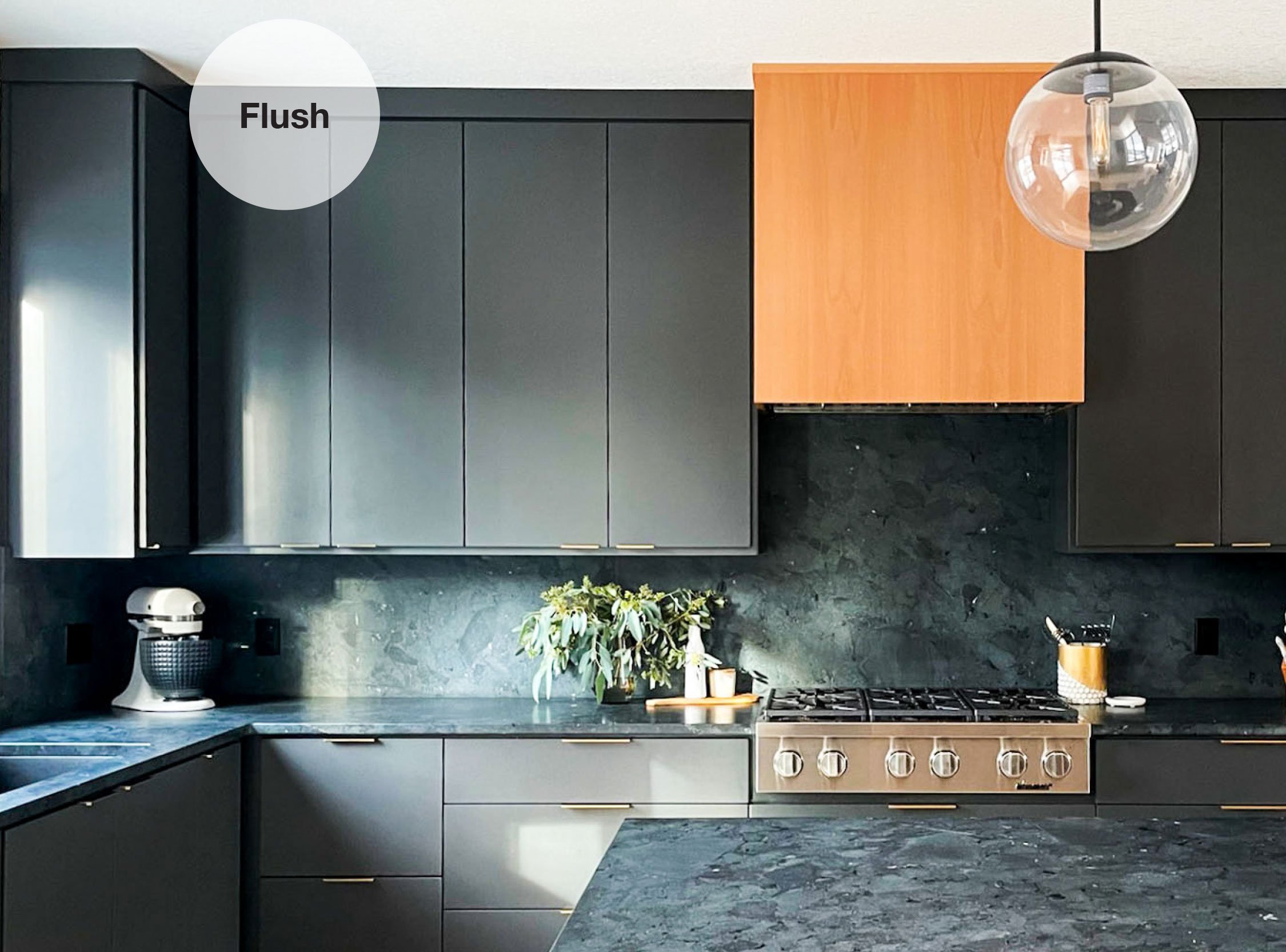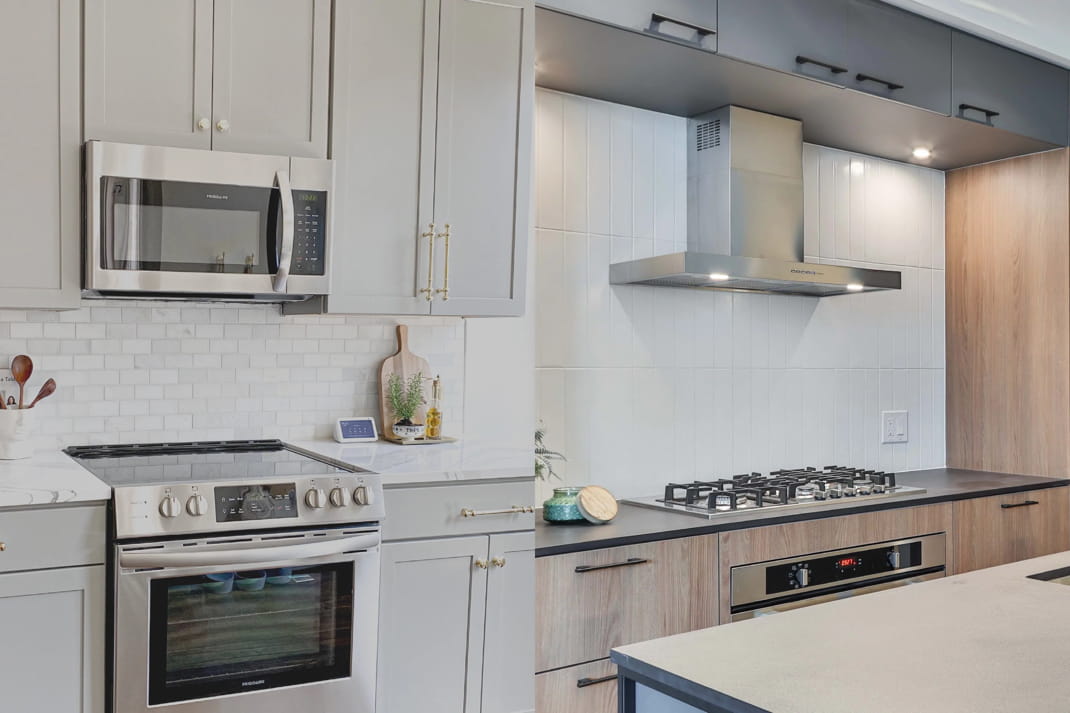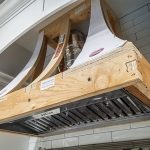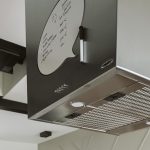No, the range hood should not go to the ceiling. The range hood should be installed at a height that allows for proper ventilation and extraction of cooking fumes, typically 24-36 inches above the cooktop.
Installing a range hood in your kitchen is essential for maintaining a clean and healthy cooking environment. It helps to eliminate smoke, grease, odors, and other pollutants that can be produced while cooking. However, determining the ideal placement of the range hood can be a critical decision.
One common question that arises is whether the range hood should be installed to the ceiling or not. In this article, we will explore the reasons why the range hood should not be mounted directly to the ceiling and discuss the recommended height for installation. By understanding the importance of proper range hood placement, you can ensure effective ventilation and a more comfortable cooking experience in your kitchen.

Credit: www.ericakaydesign.com
What Is A Range Hood And Its Purpose?
Range hoods in the kitchen serve an essential purpose in maintaining a clean and healthy cooking environment. Whether you are an experienced cook or a beginner, having a range hood can greatly improve your cooking experience. But what exactly is a range hood and why is it so important?
Let’s dive into it:
Definition Of A Range Hood
- A range hood, also known as a vent hood or exhaust hood, is a device installed above the cooktop or stove in the kitchen.
- It consists of a canopy or a fan to capture and eliminate smoke, odors, grease, and other airborne pollutants generated during cooking.
- Range hoods come in various styles and sizes, including wall-mounted, under-cabinet, island, and ceiling-mounted.
- They are typically connected to a duct system that vents the captured pollutants outside, although some models may use filters to purify the air before recirculating it back into the kitchen.
The Purpose Of A Range Hood In The Kitchen
- Eliminates cooking odors: The range hood’s primary function is to remove and filter out unpleasant cooking odors from the kitchen. It helps to keep your home smelling fresh and clean.
- Removes smoke and airborne grease particles: When you’re searing, frying, or grilling food, smoke can quickly fill the air. A range hood effectively captures and removes smoke, along with any airborne grease particles, reducing the risk of fire hazards and preventing stubborn grease stains on your walls and cabinets.
- Improves indoor air quality: Cooking can release harmful pollutants such as carbon monoxide, nitrogen dioxide, and volatile organic compounds (vocs). A range hood with proper ventilation helps expel these pollutants, providing a healthier indoor air environment for you and your family.
- Prevents the growth of mold and mildew: The steam and moisture generated during cooking can promote the growth of mold and mildew on kitchen surfaces. By venting the moist air outside, a range hood helps to control humidity levels, reducing the chances of mold and mildew formation.
- Enhances kitchen lighting: Many range hoods are equipped with built-in lights, illuminating your cooktop and workspace. This ensures better visibility while cooking and adds a functional and decorative aspect to your kitchen.
- Reduces heat buildup: A range hood helps to remove excess heat from the kitchen, especially during cooking processes that generate high temperatures. This prevents the kitchen from becoming excessively hot, making it more comfortable to cook in.
Whether you are an avid cook or simply looking to improve your kitchen’s functionality, a range hood is undoubtedly a worthwhile investment. It not only keeps your kitchen clean and odor-free but also contributes to a healthier cooking environment. So, next time you’re whipping up your culinary creations, let the range hood do its magic!
Pros Of Installing A Range Hood To The Ceiling
Range hoods are an essential component of any kitchen, as they provide vital ventilation and help maintain a pleasant and clean cooking environment. When it comes to installing a range hood, one of the decisions you may face is whether to mount it to the ceiling or place it above your stove.
In this section, we will explore the pros of installing a range hood to the ceiling, highlighting the benefits it can bring to your kitchen.
Enhanced Smoke And Odor Extraction:
- Ceiling-mounted range hoods have a greater ability to capture and remove smoke, odor, and fumes. With the higher positioning, they can effectively target and eliminate airborne particles, ensuring the air in your kitchen remains fresh and free from cooking smells.
- By being mounted to the ceiling, these hoods can cover a larger area and provide even distribution of airflow, making them highly efficient in extracting smoke and odors from your cooking space.
Efficient Heat And Steam Removal:
- A range hood mounted to the ceiling can effectively remove heat and steam generated during cooking. As hot air rises, a ceiling-mounted hood can capture these elements at their source, preventing them from spreading throughout the kitchen and making it uncomfortable to work in.
- With efficient heat and steam removal, a ceiling-mounted range hood helps regulate the temperature in your kitchen, making it more comfortable and enjoyable for cooking.
Improved Ventilation For A Cleaner Kitchen Environment:
- By installing a range hood to the ceiling, you can ensure better overall ventilation in your kitchen. It helps to eliminate grease, moisture, and other airborne particles that can accumulate on surfaces, cabinets, and walls.
- Improved ventilation not only helps maintain a cleaner kitchen but also protects the surrounding environment from potential damage caused by excess humidity and grease buildup.
Installing a range hood to the ceiling offers enhanced smoke and odor extraction, efficient heat and steam removal, and improved ventilation for a cleaner kitchen environment. These benefits contribute to a more comfortable and enjoyable cooking experience, ensuring that the air in your kitchen remains fresh and pollutant-free.
Cons Of Installing A Range Hood To The Ceiling
Installing a range hood to the ceiling can have its downsides. While it may seem like a sleek and modern choice, it’s important to consider the potential drawbacks before making a decision. Below, we’ll explore some of the cons associated with installing a range hood to the ceiling.
Higher Installation And Construction Costs:
- Installing a range hood to the ceiling typically requires more extensive construction work compared to a wall-mounted option.
- Custom ductwork may be necessary to ensure proper ventilation, adding to the overall installation costs.
- Professional installation is often required due to the complexity of the process, which can increase the overall expenses.
Limited Design Options:
- Installing a range hood to the ceiling can limit your design choices for the kitchen.
- The bulkier nature of ceiling-mounted range hoods may overpower smaller kitchen spaces, making it difficult to achieve a balanced and cohesive aesthetic.
- Depending on the kitchen layout, ceiling-mounted range hoods may obstruct sightlines and disrupt the overall flow of the space.
Difficulty In Maintenance And Cleaning:
- Cleaning a ceiling-mounted range hood can be a challenging and cumbersome task due to its height and position.
- Regular maintenance, such as grease removal and filter replacement, may require additional effort and tools to access the hood’s components.
- Without proper cleaning and maintenance, a range hood mounted to the ceiling can accumulate grease and dust, potentially compromising its effectiveness in removing smoke and odors.
Considering the potential drawbacks of installing a range hood to the ceiling, it’s essential to weigh the aesthetics and functionality against the practical aspects of installation, maintenance, and cleaning. By thoroughly evaluating these factors, you can make an informed decision that best suits your kitchen’s layout and your needs for ventilation.
Determining The Proper Height For A Range Hood
Factors To Consider When Deciding The Height
When installing a range hood in your kitchen, determining the proper height is crucial for optimal performance and functionality. Here are some key factors to consider:
- Cooking habits: If you tend to cook dishes that produce a lot of smoke, steam, or grease, a lower hood height might be necessary to effectively capture and vent the airborne particles. On the other hand, if you rarely encounter heavy cooking situations, a higher hood placement may suffice.
- Stove size: The dimensions of your stove play a role in determining the ideal height for your range hood. A general rule of thumb is to position the hood at least as wide as the cooking surface to ensure maximum coverage and ventilation.
- Ceiling height: Take into account your kitchen’s ceiling height when deciding the hood height. For higher ceilings, it’s important to ensure the range hood is positioned at a level that allows for effective air circulation and clearance from the cooking area.
- User comfort: The height of the range hood should also be considered with the user in mind. It’s crucial to position the hood at a height that allows easy access for cleaning and maintenance, while ensuring it doesn’t obstruct the cook’s line of sight or cause any potential safety hazards.
Optimal Height Recommendations From Experts
Experts in the field of kitchen ventilation have provided some guidelines for the optimal height of range hoods. Here are their recommendations:
- The national kitchen and bath association (nkba) suggests a minimum height of 24 to 30 inches between the range hood and the cooktop. This distance helps maintain optimal capture efficiency while providing enough space for larger pots and pans.
- Range hood manufacturers often provide specific guidelines for their products. It’s essential to refer to the manufacturer’s recommendations to ensure you achieve the ideal height for your specific range hood model.
- Consulting with a kitchen designer or ventilation specialist can be beneficial, as they have the expertise to help determine the optimal height for your range hood based on your kitchen layout and cooking habits.
Balancing Aesthetics And Functionality
Finding the right balance between aesthetics and functionality is crucial when deciding on the height of a range hood. A visually appealing kitchen design should not compromise the hood’s ability to effectively remove smoke, odors, and grease.
Consider these tips for achieving a harmonious balance:
- Take into account the size and style of your kitchen cabinets and backsplash. A range hood that is too low may visually overpower the space, while a hood that is too high may appear disconnected from the cooking area.
- For open-concept kitchens, maintaining a consistent sight line is important. Opt for a hood height that aligns with other elements in the space, such as pendant lights or cabinetry.
- In some cases, a custom-built range hood enclosure can be designed to seamlessly integrate the hood into the kitchen design, ensuring both functionality and aesthetics are met.
By carefully considering factors such as cooking habits, stove size, ceiling height, and user comfort, as well as incorporating expert recommendations and balancing aesthetics and functionality, you can determine the proper height for your range hood. This will ensure efficient ventilation and a visually pleasing kitchen environment.
Alternative Options To Ceiling-Mounted Range Hoods
Range hoods are essential components of the modern kitchen, helping to keep the air clean and free from smoke, odors, and grease. While ceiling-mounted range hoods are a popular choice for many homeowners, they may not always be the best option for every kitchen.
Thankfully, there are alternative choices available that can be just as effective in providing ventilation and maintaining air quality. In this section, we will explore three such options: under-cabinet range hoods, wall-mounted range hoods, and downdraft ventilation systems.
Under-Cabinet Range Hoods:
- Designed to fit neatly beneath kitchen cabinets, under-cabinet range hoods are an excellent choice for kitchens with limited space.
- These hoods provide effective ventilation, drawing in smoke, steam, and grease, and expelling it through ducts to the outside or filtering it through a charcoal filter and recirculating it back into the kitchen.
- Under-cabinet range hoods come in various sizes and styles, ensuring there is a suitable option for every kitchen décor.
- They can be easily installed and are relatively affordable compared to other range hood options.
- With their compact design, under-cabinet range hoods are an excellent choice for those who want a practical and efficient ventilation solution for their kitchen.
Wall-Mounted Range Hoods:
- Wall-mounted range hoods are installed directly against the kitchen wall, just above the cooking area.
- These hoods are a popular choice in contemporary kitchens due to their sleek and stylish design.
- Wall-mounted range hoods provide excellent ventilation by capturing and eliminating smoke, steam, and cooking odors directly from the source.
- They come in various sizes, styles, and materials to match any kitchen aesthetic.
- Wall-mounted range hoods can be vented to the outside or can recirculate the air after passing it through filters, removing impurities before releasing it back into the kitchen.
- With their prominent placement against the wall, these hoods can also become a striking focal point in the kitchen’s overall design.
Downdraft Ventilation Systems:
- Downdraft ventilation systems are an alternative option to traditional ceiling-mounted range hoods, known for their discreet design and space-saving capabilities.
- Conceptually different from other range hoods, downdraft systems are installed beside or behind the cooktop and rise up when in use.
- These systems effectively capture cooking fumes and odors by pulling them downwards and venting them outside or filtering and recirculating the air.
- Downdraft ventilation systems are particularly suitable for kitchens where a ceiling-mounted range hood is impractical due to design constraints or preferences for an unobtrusive appearance.
- While not as commonly used as ceiling-mounted or wall-mounted range hoods, downdraft systems offer unique benefits for those seeking a more inconspicuous ventilation option.
When it comes to range hoods, ceiling-mounted options may not be the only or the most suitable choice. Under-cabinet range hoods, wall-mounted range hoods, and downdraft ventilation systems provide viable alternatives that can effectively ventilate your kitchen while respecting the space and design requirements of the area.
Take into consideration your kitchen layout, style preferences, and ventilation needs to select the range hood option that best fits your unique requirements and enhances your overall cooking experience.
Tips For Choosing The Right Range Hood Configuration
Assessing Kitchen Layout And Size
When it comes to choosing the right range hood configuration, it’s important to assess your kitchen layout and size. Consider the following key points:
- Evaluate the size of your kitchen: Larger kitchens may require more powerful range hoods to effectively remove smoke and odors, while smaller kitchens may do well with smaller, compact models. Assess the dimensions of your kitchen to determine the appropriate range hood size.
- Consider the layout of your kitchen: The layout of your kitchen plays a significant role in determining the optimal range hood configuration. If your range is located against a wall, a wall-mounted range hood may be most suitable. For kitchen islands or cooktops located away from walls, a ceiling-mounted island range hood may be the better choice.
- Think about ventilation options: Assess the availability of ventilation options in your kitchen. If your kitchen already has proper ductwork or ventilation systems in place, you can consider ducted range hoods for efficient air extraction. If ductwork is not feasible, you can opt for ductless range hoods that filter and recirculate the air.
- Take into account aesthetic considerations: The range hood configuration you choose should enhance the overall aesthetic of your kitchen. Consider the style and design of your kitchen and look for range hoods that complement the existing décor.
Considerations For Cooking Habits And Frequency
To choose the right range hood configuration, it’s important to take your cooking habits and frequency into account. Here are some key points to consider:
- Cooking frequency: If you frequently cook meals that involve a lot of frying, grilling, or high-heat cooking, you will need a range hood with a higher extraction capacity to effectively remove smoke and grease particles. Consider range hoods with higher cfm (cubic feet per minute) ratings to accommodate your cooking frequency.
- Types of cooking: The types of cooking you frequently engage in can also influence your range hood choice. If you often cook with strong spices or have a preference for cooking styles that generate excessive smoke, an efficient range hood with powerful extraction capabilities is essential.
- Noise level: Some range hoods can be quite noisy, which can be disruptive, especially in open-concept kitchen designs. Consider range hoods that offer low-noise or ultra-quiet operation if noise is a concern for you.
Consulting With A Professional For Personalized Recommendations
To ensure you choose the right range hood configuration for your specific needs, it’s always a good idea to consult with a professional. They can provide personalized recommendations based on your kitchen layout, cooking habits, and other relevant factors. Here are some reasons why consulting with a professional is beneficial:
- Expert knowledge: Professionals in the field have extensive knowledge and expertise when it comes to range hoods. They can assess your unique situation and provide insights that you may not be aware of.
- Customized solutions: Every kitchen is different, and a professional can help tailor a range hood configuration that best suits your specific requirements. They can take into account factors such as ductwork availability, noise considerations, and aesthetic preferences.
- Enhanced performance: With their expertise, professionals can recommend range hood configurations that offer optimal performance in terms of air extraction and filtration. This ensures that your kitchen remains clean, odor-free, and well-ventilated during cooking.
By considering your kitchen layout and size, your cooking habits and frequency, and consulting with a professional, you can make an informed decision when choosing the right range hood configuration for your kitchen.
Maintenance And Cleaning Of Ceiling-Mounted Range Hoods
In the realm of kitchen ventilation, the debate of whether a range hood should go all the way up to the ceiling is a hot topic. While there are valid arguments on both sides, one critical aspect that deserves our attention is the maintenance and cleaning of ceiling-mounted range hoods.
Ensuring the efficiency and longevity of these units requires regular cleaning practices, understanding the right cleaning products and techniques, as well as overcoming potential challenges along the way.
Regular Cleaning Practices For Maintaining Efficiency
- Remove and clean the filters: Regularly taking out and cleaning the filters is essential to keep your ceiling-mounted range hood running efficiently. This helps prevent the accumulation of grease and other particles that can obstruct airflow.
- Clean the exterior surfaces: Dust, grime, and grease can build up on the exterior surfaces of the range hood, affecting its aesthetics and functionality. Regularly wipe down these surfaces using a mild detergent solution or an appropriate cleaning agent to maintain their cleanliness and ensure optimal performance.
- Check the exhaust ducts: Over time, the exhaust ducts of your ceiling-mounted range hood can become clogged with grease and debris. Inspect and clean these ducts periodically to prevent any blockages that may hinder the proper venting of air and odors from your kitchen.
Recommended Cleaning Products And Techniques
- Vinegar solution: A simple and effective cleaning solution for range hoods is a mixture of vinegar and warm water. This natural solution helps break down grease and grime without causing any damage to the unit.
- Degreasing agents: For stubborn grease and stains, you may need to use specialized degreasing agents. Look for products that are safe to use on range hood surfaces and follow the manufacturer’s instructions for optimum results.
- Soft cloths or sponges: When cleaning the range hood, it’s essential to use non-abrasive materials to avoid scratching or damaging the surfaces. Soft microfiber cloths or sponges are ideal for wiping down the exterior and interior parts of the hood.
Potential Challenges And How To Overcome Them
- Accessing hard-to-reach areas: Cleaning a ceiling-mounted range hood can be challenging, especially when it comes to reaching high or tight spaces. Consider using an extendable cleaning tool or a ladder to access these areas safely and effectively.
- Grease build-up in filters: Even with regular cleaning, grease can accumulate in the filters, making them less efficient over time. To overcome this challenge, consider replacing the filters periodically to ensure proper ventilation and airflow.
- Removing stubborn stains: Sometimes, stubborn stains or residue may be difficult to remove using regular cleaning methods. In such cases, consult the manufacturer’s guidelines or seek professional assistance to tackle these tough stains without causing damage to your range hood.
By following these regular cleaning practices, using recommended cleaning products and techniques, and addressing potential challenges, you can ensure the efficiency and longevity of your ceiling-mounted range hood. Regular maintenance will not only enhance the performance of your kitchen ventilation system but also contribute to a healthier cooking environment in your home.
Frequently Asked Questions For Should Range Hood Go To Ceiling
Can A Range Hood Be Vented Through The Ceiling?
Yes, a range hood can be vented through the ceiling. However, it requires proper ductwork installation to ensure that the exhaust air is efficiently and safely removed from the kitchen area.
What Are The Benefits Of A Ceiling-Mounted Range Hood?
A ceiling-mounted range hood offers several benefits. It provides better ventilation by capturing cooking fumes at a higher level. It also saves space, as it doesn’t obstruct upper cabinets. Additionally, it adds a sleek and modern aesthetic to the kitchen.
Does A Range Hood Need To Be The Same Size As The Cooktop?
Ideally, the size of the range hood should be slightly wider than the cooktop to effectively capture the steam, smoke, and odors. Having a larger hood ensures better coverage and extraction. However, be mindful of the overall dimensions and design of the kitchen for a cohesive look.
Can A Ceiling-Mounted Range Hood Be Installed In Any Kitchen?
While a ceiling-mounted range hood can be installed in most kitchens, it is important to consider the ceiling height. The ceiling must be at a sufficient height to accommodate the height of the range hood and allow for proper airflow.
Consulting a professional is recommended.
Should A Range Hood Be Ducted To The Outside Or Recirculated?
Ducting a range hood to the outside is generally preferred as it exhausts the smoke, odor, and grease directly outdoors. This option provides better ventilation and prevents the recirculation of polluted air. However, in certain situations where ducting is not possible, a recirculating range hood with a charcoal filter can be used.
What Is The Recommended Distance Between The Range Hood And The Cooktop?
The recommended distance between the range hood and the cooktop is typically 24 to 30 inches. This allows for efficient capture of cooking fumes while ensuring safety and preventing any damage to the range hood or cooktop. Refer to the manufacturer’s guidelines for specific recommendations.
Conclusion
The decision to install a range hood that goes to the ceiling is ultimately a personal one. While it does offer certain benefits such as better ventilation and a sleeker appearance, there are also factors to consider such as the height of your ceiling and the overall cost.
Additionally, the size and layout of your kitchen may also play a role in your decision. Ultimately, it is important to assess your specific needs and preferences before making a final choice. Whether you decide to install a range hood that goes to the ceiling or opt for a more traditional option, make sure it meets the necessary safety and functionality requirements.
Remember, a range hood is an important appliance that helps improve air quality in your kitchen, so choose wisely and enjoy a fresh and clean environment for your cooking adventures.

Freda is a passionate foodie and kitchen gadget enthusiast. With over 10 years of experience in the culinary industry, Freda brings her expertise in testing and reviewing kitchen gadgets.





